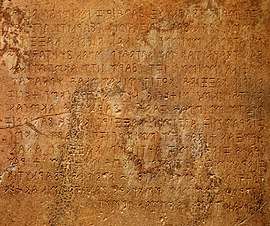Lydian alphabet
| Lydian | |
|---|---|
 | |
| Type |
Alphabet
|
| Languages | Lydian language |
Time period | 700-200 BCE |
Parent systems | |
Sister systems | Other Alphabets of Asia Minor |
| Direction | Right-to-left |
| ISO 15924 |
Lydi, 116 |
Unicode alias | Lydian |
| U+10920–U+1093F | |
Lydian script was used to write the Lydian language. Like other scripts of Anatolia in the Iron Age, the Lydian alphabet is related to the East Greek alphabet, but it has unique features.
The first modern codification of the Lydian alphabet was made by Roberto Gusmani in 1964, in a combined lexicon, grammar, and text collection.
Early Lydian texts were written either from left to right or from right to left. Later texts all run from right to left. One surviving text is in the bi-directional boustrophedon manner. Spaces separate words except in one text that uses dots instead. Lydian uniquely features a quotation mark in the shape of a right triangle.
Alphabet
The Lydian alphabet[2][3] is closely related to the other alphabets of Asia Minor as well as to the Greek alphabet. It contains letters for 26 sounds. Some are represented by more than one symbol, which is considered one "letter." Unlike the Carian alphabet, which had an f derived from Φ, the Lydian f has the peculiar 8 shape also found in the Etruscan alphabet.
| Letter | Transliteration | Sound (IPA) | Notes | |
|---|---|---|---|---|
| Text | Image | |||
| 𐤠 | a | [a] | ||
| 𐤡 | b | [p], [b] | Voiced to [b] before nasals and probably [r] | |
| 𐤢 | g | [ɡ] | Occasionally substituted for voiced /k/. | |
| 𐤣 | d | [ð]? | Or perhaps some other voiced fricative such as [z]. | |
| 𐤤 | e | [eː] | Fairly high and long, like Greek ει; only occurs accented. | |
| 𐤥 | v | [v] | ||
| 𐤦 | i | [i] | ||
| 𐤧 | y | ? | Apparently an allophone of /i/, perhaps when unstressed. Attested only 11 times: artymu- ~ artimu-.[4] It may be a borrowing of Carian 𐊹. | |
| 𐤨 | k | [k], [ɡ] | Voiced to [ɡ] before nasals and probably [r] | |
| 𐤩 | l | [l] | ||
| 𐤪 | m | [m] | ||
| 𐤫 | n | [n] | ||
| 𐤬 | o | [oː] | Fairly high and long, like Greek ου; only occurs accented. | |
| 𐤭 | r | [r] | ||
| 𐤮 | ś | [s] | A simple [s], despite its transcription. | |
| 𐤯 | t | [t], [d] | Voiced to [d] before nasals and probably [r] | |
| 𐤰 | u | [u] | ||
| 𐤱 | f | [f] | ||
| 𐤲 | q | [kʷ] | At least historically [kʷ]; it's not clear if this pronunciation was still current. | |
| 𐤳 | s | [ç] or [ʃ] | Palatalized *s. | |
| 𐤴 | τ | [ts] or [tʃ] | ||
| 𐤵 | ã | nasal vowel | Perhaps [ãː]. Only occurs accented. Ã or a is found before a nasal consonant: aliksãntru ~ aliksantru.[5] | |
| 𐤶 | ẽ | nasal vowel | Not [ẽ]; perhaps [ã]. Only occurs accented. | |
| 𐤷 | λ | [ʎ] | Palatalized *l. | |
| 𐤸 | ν | [ɲ] or [ŋ]? | Arose from word-final *m and *n; later loss of final vowels caused it to contrast with those sounds. | |
| 𐤹 | c | [dz]? | An undetermined voiced affricate or fricative: [z], [dz], or [dʒ], etc. At least one origin is assibilated *d. | |
In addition two digraphs, aa and ii, appear to be allophones of [a] and [i] under speculative circumstances, such as lengthening from stress.[6] A schwa was evidently not written: dctdid, kśbλtok-.
Examples of words
𐤬𐤭𐤠 (Image: ![]()
![]()
![]()
𐤩𐤠𐤲𐤭𐤦𐤳𐤠 (Image: ![]()
![]()
![]()
![]()
![]()
![]()
![]()
𐤡𐤦𐤭𐤠 (Image: ![]()
![]()
![]()
![]()
Unicode
The Lydian alphabet was added to the Unicode Standard in April, 2008 with the release of version 5.1. It is encoded in Plane 1 (Supplementary Multilingual Plane).
The Unicode block for Lydian is U+10920–U+1093F:
| Lydian[1][2] Official Unicode Consortium code chart (PDF) | ||||||||||||||||
| 0 | 1 | 2 | 3 | 4 | 5 | 6 | 7 | 8 | 9 | A | B | C | D | E | F | |
| U+1092x | 𐤠 | 𐤡 | 𐤢 | 𐤣 | 𐤤 | 𐤥 | 𐤦 | 𐤧 | 𐤨 | 𐤩 | 𐤪 | 𐤫 | 𐤬 | 𐤭 | 𐤮 | 𐤯 |
| U+1093x | 𐤰 | 𐤱 | 𐤲 | 𐤳 | 𐤴 | 𐤵 | 𐤶 | 𐤷 | 𐤸 | 𐤹 | 𐤿 | |||||
| Notes | ||||||||||||||||
See also
Notes
External links
- Everson, Michael (2006-02-05). "N3019R2: Proposal to encode the Lycian and Lydian scripts in the SMP of the UCS" (pdf). DKUUG Standardization. Danish Unix User Group (DKUUG). Retrieved 2008-03-18.
References
- Adiego, I. J. (2007). "Greek and Lydian". In Christidis, A.F.; Arapopoulou, Maria; Chriti, Maria. A History of Ancient Greek From the Beginning to Late Antiquity. Chris Markham (trans.). Cambridge University press. ISBN 0-521-83307-8. . Translator Chris Markham.
- Gérard, Raphaël (2005). Phonétique et morphologie de la langue lydienne. Louvain-la-Neuve: Peeters. ISBN 9042915749. French language text.
- Gusmani, R. Lydisches Wörterbuch. Mit grammatischer Skizze und Inschriftensammlung, Heidelberg 1964 (Ergänzungsband 1-3, Heidelberg 1980-1986).
- Melchert, H. Craig (2004) "Lydian", in Roger D. Woodard (ed.), The Cambridge Encyclopedia of the World's Ancient Languages. Cambridge: Cambridge University Press. ISBN 0-521-56256-2. pp. 601–608.
- Shevoroshkin, V. The Lydian Language, Moscow, 1977.
